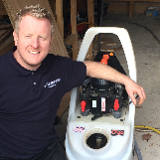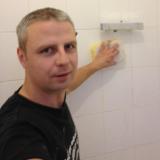
Ray Trueman
It sounds like you need a powerflush and a magnetic filter fitted if you go on the kamco website there is a list of kamco trained engineers pick one in your area then you will get a professional engineers hope this helps cheers Ray

It sounds like you need a powerflush and a magnetic filter fitted if you go on the kamco website there is a list of kamco trained engineers pick one in your area then you will get a professional engineers hope this helps cheers Ray

Hi Denis All what you are described are symptoms of sludge build up in your CH system so Sanitel won't help only power flushing will do a job. Power Flushing is a process by which heating systems are forcibly cleansed using water at high velocity, but low pressure, so that no physical damage is caused to the system.The process can be made even more effective with the addition of powerful cleaning agents (CHEMICALS) The objective is to restore systems with circulation and boiler noise problems (caused by sludge and corrosion deposits) to optimum operation.Power flushing removes these deposits and the problems that they cause.... It is prudent to power flush a heating system immediately before fitting a new boiler to an existing system to prevent possible future problems.Many systems are found to contain corrosion and sludge, even if no flow problems have yet shown themselves. Existing debris is often mobilised by alterations to the system/piping and the increased efficiency of the new boiler, and may then accumulate in the boiler heat exchanger, causing noisy operation, reduced efficiency and, in extreme circumstances, failure of the boiler. The high efficiency and compactness of modern boilers, developed to minimise fuel costs and pollution, means that they are more susceptible to problems caused by debris in the system water. The power flushing process is a versatile, easy to use and highly effective method of flushing heating systems. By utilising system flushing pumps, heating systems can be purged of sludge, scale and corrosion deposits with minimal dismantling and disruption. The power flushing pump is simply connected into the heating system, either across standard circulator pump couplings, across the tails of one radiator, or wherever most practicable. The powerful flow, combined with instantaneous flow reverser device, will dislodge and mobilise deposits and corrosion which resist traditional system cleaning methods. Once the corrosion and sludge deposits have been loosened and mobilised, fresh clean water is forced through the heating system, pushing the contaminated water out through a full bore dump valve to waste. During the process, radiators are individually flushed, without removing or disconnecting them from the system, by directing the full output of the pump through each radiator separately. At the end of the flushing process, the system contains fresh clean water and reinstatement of the system to normal operation takes only a few minutes. System flushing will not remedy design or mechanical faults, which should be rectified, but in many cases it will cure the problems caused by these. I hope this will help Regards Rafal
Nick shares his story of finding local tradespeople in his new area.